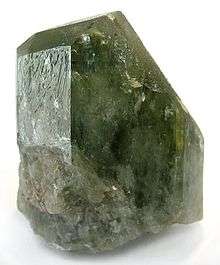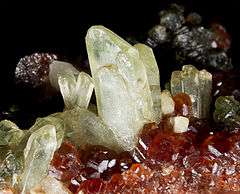Diopside
| Diopside | |
|---|---|
|
Diopside - Bellecombe, Châtillon, Aosta Valley, Italy | |
| General | |
| Category | Silicate mineral |
| Formula (repeating unit) | MgCaSi2O6 |
| Crystal symmetry | Monoclinic 2/m - prismatic |
| Unit cell | a = 9.746 Å, b = 8.899 Å, c = 5.251 Å; β = 105.79°; Z = 4 |
| Identification | |
| Color | Commonly light to dark green; may be blue, brown, colorless, white, grey |
| Crystal habit | Short prismatic crystals common, may be granular, columnar, massive |
| Crystal system | Monoclinic |
| Twinning | Simple and multiple twins common on {100} and {001} |
| Cleavage | Distinct/good on {110} |
| Fracture | Irregular/uneven, conchoidal |
| Tenacity | Brittle |
| Mohs scale hardness | 5.5 - 6.5 |
| Luster | Vitreous to dull |
| Streak | white |
| Specific gravity | 3.278 |
| Optical properties | Biaxial (+) |
| Refractive index | nα= 1.663 - 1.699, nβ= 1.671 - 1.705, nγ= 1.693 - 1.728 |
| Birefringence | δ = 0.030 |
| 2V angle | Measured: 58° to 63° |
| Dispersion | Weak to distinct, r>v |
| Melting point | 1391 °C |
| References | [1][2][3] |
Diopside is a monoclinic pyroxene mineral with composition MgCaSi2O6. It forms complete solid solution series with hedenbergite (FeCaSi2O6) and augite, and partial solid solutions with orthopyroxene and pigeonite. It forms variably colored, but typically dull green crystals in the monoclinic prismatic class. It has two distinct prismatic cleavages at 87 and 93° typical of the pyroxene series. It has a Mohs hardness of six, a Vickers hardness of 7.7 GPa at a load of 0.98 N,[4] and a specific gravity of 3.25 to 3.55. It is transparent to translucent with indices of refraction of nα=1.663–1.699, nβ=1.671–1.705, and nγ=1.693–1.728. The optic angle is 58° to 63°.
Formation

Diopside is found in ultramafic (kimberlite and peridotite) igneous rocks, and diopside-rich augite is common in mafic rocks, such as olivine basalt and andesite. Diopside is also found in a variety of metamorphic rocks, such as in contact metamorphosed skarns developed from high silica dolomites. It is an important mineral in the Earth's mantle and is common in peridotite xenoliths erupted in kimberlite and alkali basalt.
Mineralogy and occurrence
Diopside is a precursor of chrysotile (white asbestos) by hydrothermal alteration and magmatic differentiation;[5] it can react with hydrous solutions of magnesium and chlorine to yield chrysotile by heating at 600 °C for three days.[6] Some vermiculite deposits, most notably those in Libby, Montana, are contaminated with chrysotile (as well as other forms of asbestos) that formed from diopside.[7]
At relatively high temperatures, there is a miscibility gap between diopside and pigeonite, and at lower temperatures, between diopside and orthopyroxene. The calcium/(calcium+magnesium+iron) ratio in diopside that formed with one of these other two pyroxenes is particularly sensitive to temperature above 900 °C, and compositions of diopside in peridotite xenoliths have been important in reconstructions of temperatures in the Earth's mantle.
Chrome diopside ((Ca,Na,Mg,Fe,Cr)2(Si,Al)2O6) is a common constituent of peridotite xenoliths, and dispersed grains are found near kimberlite pipes, and as such are a prospecting indicator for diamonds. Occurrences are reported in Canada, South Africa, Russia, Brazil, and a wide variety of other locations. In the US, chromian diopside localities are described in the serpentinite belt in northern California, in kimberlite in the Colorado-Wyoming State Line district, in kimberlite in the Iron Mountain district, Wyoming, in lamprophyre at Cedar Mountain in Wyoming, and in numerous anthills and outcrops of the Tertiary Bishop Conglomerate in the Green River Basin of Wyoming. Much chromian diopside from the Green River Basin localities and several of the State Line Kimberlites have been gem in character.[8]
As a gem
Gemstone quality diopside is found in two forms: the black star diopside and the chrome diopside (which includes chromium, giving it a rich green colour). At 5.5–6.5 on the Mohs scale, chrome diopside is relatively soft to scratch. Due to the deep green nature of the gem they are sometimes referred to as Siberian emeralds, though they are on a mineralogical level completely unrelated. Emerald being a precious stone and diopside being a semi-precious stone.[9]
Violane is a manganese-rich variety of diopside, violet to light blue in colour.[10]
Etymology and history
Diopside derives its name from the Greek dis, "twice", and òpsè, "face" in reference to the two ways of orienting the vertical prism.
Diopside was discovered and first described about 1800, by Brazilian naturalist Jose Bonifacio de Andrada e Silva.
Potential uses
Diopside based ceramics and glass-ceramics have potential applications in various technological areas. A diopside based glass-ceramic named 'silceram' was produced by scientists from Imperial College, UK during the 1980s from blast furnace slag and other waste products. The as produced glass-ceramic is a potential structural material. Similarly, diopside based ceramics and glass-ceramics have potential applications in the field of biomaterials, nuclear waste immobilization and sealing materials in solid oxide fuel cells.
References
- ↑ C. D. Gribble, ed. (1988). "The Silicate Minerals". Rutley's Elements of Mineralogy (27th ed.). London: Unwin Hyman Ltd. p. 378. ISBN 0-04-549011-2.
- ↑ Mindat page for Diopside
- ↑ Handbook of Mineralogy
- ↑ M M Smedskjaer, M Jensen, and Y-Z Yue (2008). "Theoretical calculation and measurement of the hardness of diopside". Journal of the American Ceramic Society 91 (2): 514–518. doi:10.1111/j.1551-2916.2007.02166.x.
- ↑ A L Boettcher (1967). "The Rainy Creek alkaline-ultramafic igneous complex near Libby, Montana. I: Ultramafic rocks and fenite". Journal of Geology 75: 536–553. doi:10.1086/627280.
- ↑ Eugenio Barrese, Elena Belluso, and Francesco Abbona (1 February 1997). "On the transformation of synthetic diopside into chrysotile". European Journal of Mineralogy 9 (1): 83–87. doi:10.1127/ejm/9/1/0083.
- ↑ "Asbestos in Your Home". United States Environmental Protection Agency. 2003. Archived from the original on October 8, 2006. Retrieved 2007-11-20.
- ↑ Hausel, W. Dan (2006). Geology and Geochemistry of the Leucite Hills Lamproitic field, Rocks Springs Uplift, Wyoming. laramie, Wyoming: Wyoming geological survey.
- ↑ Kalotay, Daphne (2010). Russian Winter (First ed.). New York, NY: Harper. pp. 184–185. ISBN 978-0-06-196216-5.
- ↑ Mindat page for Violane
- S. Carter, C.B. Ponton, R.D. Rawlings, P.S. Rogers, Microstructure, chemistry, elastic properties and internal-friction of silceram glass-ceramics, Journal of Materials Science 23 (1988) 2622-2630.
- T. Nonami, S. Tsutsumi, Study of diopside ceramics for biomaterials, Journal of Materials Science: Materials in Medicine 10 (1999) 475-479.
- A. Karnis, L. Gautron, Promising Immobilization of cadmium and Lead inside Ca-rich Glass-Ceramics, Proceedings of World Academy of Science, Engineering and Technology, vol. 40 (2009) ISSN 2070-3740.
- A. Goel, D.U. Tulyaganov, V.V. Kharton, A.A. Yaremchenko, J.M.F. Ferreira, Electrical behaviour of aluminosilicate glass-ceramic sealants and their interaction with metallic SOFC interconnects, Journal of Power Sources 195 (2010) 522-526.
- Hurlbut, Cornelius S.; Klein, Cornelis, 1985, Manual of Mineralogy, 20th ed., Wiley, pp 403–404, ISBN 0-471-80580-7
- Mindat: Chromian diopside, with locales
- Webmineral
- Chrome Diopside on gemstone.org
| Wikimedia Commons has media related to Diopside. |
| ||||||||||||||||||||||||||||||||||||||||||||||||||||||
